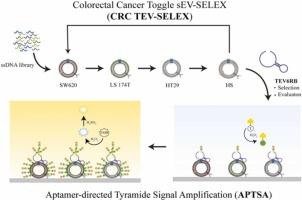Aptamer-directed tyramide signal amplification for ultrasensitive detection of small extracellular vesicles for temporally heterogenous colorectal cancer
IF 8
1区 化学
Q1 CHEMISTRY, ANALYTICAL
引用次数: 0
Abstract
Colorectal cancer (CRC) is the most common gastrointestinal neoplasm, with a significant global disease burden. Current diagnostic modalities for CRC largely involve invasive methods, limiting the early diagnosis of CRC. Tumor-derived small extracellular vesicles (sEVs) are extracellularly secreted nanoscale vesicles carrying various biomolecules with intercellular messages, which regulate tumor progression and metastasis. In this study, TEV6RB, a novel aptamer with a 37-nucleotide sequence specific to CRC sEVs, was developed via CRC Toggle sEVs Systematic Evolution of Ligands by EXponential enrichment (TEV-SELEX) using various Dukes' staging CRC cell-derived sEVs. TEV6RB, with a parallel G-quadruplex structure, exhibited high binding affinities for CRC sEVs with low nanomolar dissociation constants (Kd; 3.848, 5.904, and 5.234 nM for SW620, LS 174 T, and HT29 cells, respectively). By using TEV6RB aptamer and tyramide signal amplification, our aptamer-directed tyramide signal amplification system (APTSA) achieved ultrasensitive detection of CRC sEVs with limit-of-detection values of 3.6 × 102, 3.5 × 103, and 8.4 × 102 particles/μL for SW620, LS 174 T, and HT29 cells, respectively. This system further validated its high specificity in distinguishing CRC sEVs from healthy and normal colon samples. Our system presents a potential liquid biopsy approach for sEVs-mediated diagnosis of CRC.

求助全文
约1分钟内获得全文
求助全文
来源期刊

Sensors and Actuators B: Chemical
工程技术-电化学
CiteScore
14.60
自引率
11.90%
发文量
1776
审稿时长
3.2 months
期刊介绍:
Sensors & Actuators, B: Chemical is an international journal focused on the research and development of chemical transducers. It covers chemical sensors and biosensors, chemical actuators, and analytical microsystems. The journal is interdisciplinary, aiming to publish original works showcasing substantial advancements beyond the current state of the art in these fields, with practical applicability to solving meaningful analytical problems. Review articles are accepted by invitation from an Editor of the journal.
 求助内容:
求助内容: 应助结果提醒方式:
应助结果提醒方式:


